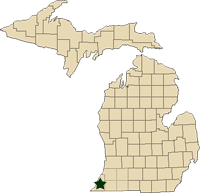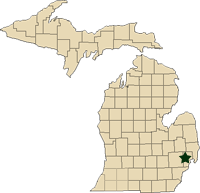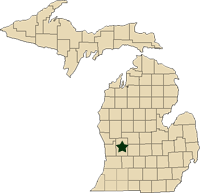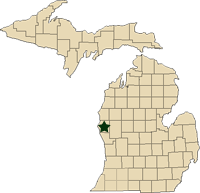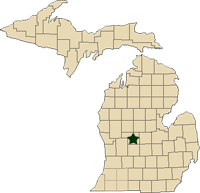Regional reports on Michigan vegetables – August 10, 2011
MSU Extension educators’ pest and vegetable updates for Michigan.
This week’s regional reports:
- Southwest Michigan – Ron Goldy
- East Michigan (Lapeer, Macomb, St. Clair) – Hannah Stevens
- Grand Rapids Area – Bill Steenwyk
- West Central Michigan – Norm Myers
- Central Michigan – Fred Springborn
Southwest Michigan – Ron Goldy, Michigan State University Extension
|
Weather
Over the past week, temperatures averaged near normal with highs from 78 to 87°F and lows from 62 to 68°F. The area received 1.5 or more inches of rain. Some damaging hail occurred Sunday (August 7). Most sites now have adequate moisture.
Crop reports
General cantaloupe harvest has begun. Watermelon harvest will start next week. Harvest continues on other crops. Downy mildew has been observed on cucumbers.
Some early planted tomato fields are finished, some because of the high incidence of bacterial problems. Bacterial spot and speck continues to show up. Mite populations are increasing in tomatoes and other susceptible crops.
Bacterial spot continues to show up in some pepper plantings.
European corn borer numbers remain low, being at “0” for this week.
Potato harvest has begun.
East Michigan (Lapeer, Macomb, St. Clair) – Hannah Stevens, Michigan State University Extension
|
Field conditions
Rainfall continued this week on four to five occasions, totaling 2 inches or somewhat more in this area. High temperatures have been much cooler than last week, in the low 80°F range. One can see standing water in some areas, and harvest and crop protection operations are messy, but overall I hope the moisture situation is not causing crop losses.
Crop conditions
Sweet corn is now in abundance as growers are into second and even third plantings. There may be minor problems with ear fill as a result of pollination or fertilization problems during the hot weather, but otherwise the ears are of good quality. Corn earworm and European corn borer trap catches remain fairly steady.
In cole crops, summer broccoli has been of poor quality, but cabbage and other cole crops seems to be doing well, with the exception of some bacterial soft rot of cabbage heads, possibly introduced by insects. Cauliflower heads are being tied. The potential yield of the first set of tomatoes seems exceptionally high, but I observed some radial cracking of maturing fruit.
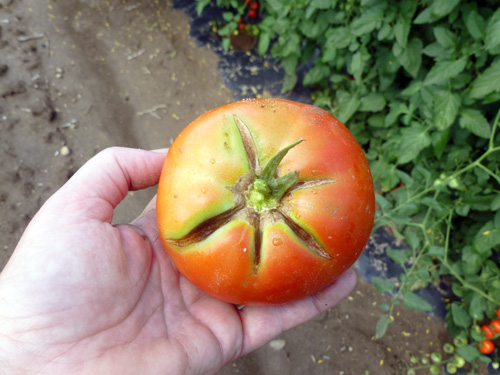
Radial cracking on tomato.
In vine crops, gardeners and small market gardeners are reporting fruit abortion in summer squash, which I associate with incomplete blossom fertilization, but not necessarily poor pollination. Muskmelons and watermelons are now being harvested. Powdery mildew is now among us and foliar fungicides need to be considered on vine crops, including winter squash and pumpkins. Downy mildew on cucumbersis very likely widespread and will become apparent in unprotected fields. Wholesale carrot harvest began today (August 10) in the Imlay City area.
Grand Rapids Area – Bill Steenwyk, Michigan State University Extension
|
Over the past week, rainfall ranged from a modest 0.4 to 0.7 inches. Temperatures were seasonably warm, with highs averaging in the mid-80s and lows in the mid-60s.
Celery harvest continues with a positive overall picture. Aphids pose one of the more severe pest pressures, with reduced variegated cutworm activity and light to moderate infestations of aster leafhoppers. Some early blight is present in areas north of Grand Rapids/Allendale. Celery anthracnose is evident in many fields, but at much lower levels than last year.
A few of the earliest onions have been harvested. Leaves are dropping in other early stands. The crop is facing pressure from a number of foliar diseases, including purple spot and anthracnose. Lettuce and radish yield vary by location, with yields being somewhat lower than hoped for due to recent heavy rains.
The condition of tomatoes varies by location. Many fields look good, but some areas have experienced lower yields due to foliar diseases. The same can be said for peppers. The eggplants that I have seen look good.
Cabbage has been doing well this season. Lately, however, some fields in wetter locations are experiencing a variety of disease challenges. Sweet corn yields appear to be good overall. Some larval feeding in the ears is present. A local crop consultant has found that corn earworm is a much more significant problem than European corn borer. Western bean cutworm populations have been low. My three southern Kent County European corn borer pheromone traps had moth counts of 0, 3 and 5.
Vine crops are ripening fast.Melons are on market shelves. Winter squash harvest continues with positive overall reports. Phytophthora wilt appears to be a challenge in some of the wetter areas. Powdery mildew is present. Downy mildew has been identified in west Michigan cucumber fields.
West Central Michigan – Norm Myers, Michigan State University Extension
|
Weather during this last week was above normal and rains were variable. The main vegetable growing belt is drier than other parts of the county and irrigators there are very busy keeping up with crop demands.
Asparagus growers continue to do a good job controlling foliar diseases. Because of the favorable disease environment, the Tom-Cast system will likely not save any fungicide sprays this year, but initial evaluations indicate that growers credit it with increasing or preserving yields over time. A second flush of new growth is appearing in most fields. Fortunately, we still have enough of the growing season left that asparagus crowns should be able to at least recoup the investment in new fern.
Disease pressure remains high in vine crops as well. Powdery mildew arrived early this year, but so far growers have been able to control it. Phytophthora capsici has also made its appearance over the last week or so. Most of the damage to date appears to be from the fruit rot stage of the disease. Watermelon mosaic virus seems to be our only virus problem. Fruit set on all vine crops appears to be light this year. Most growers are blaming the effect of the heat on bee pollination for that light set.
In carrots, disease pressure seems even higher than in asparagus, probably due to the added wetness from irrigation. Low aster yellows indexes appear to be proving out in lower than normal aster yellows rates in carrots. Partly that is because aster leafhopper numbers are also lower than usual for this point in the season.
I caught one European corn borer moth, but my corn earworm moth catch jumped to five this week. Western bean cutworm numbers have dropped off greatly this week, with only one moth caught in my sweet corn site and only three in my field corn site.
We harvested our early snap bean plantings last week and growers were a little disappointed with the yields. In talking to one of the large snap bean growers from southern Michigan, this situation seems to be general. The growers, rightly I think, are blaming the heat for blossom abortion as the main factor in lower yields.
Central Michigan – Fred Springborn, Michigan State University Extension
|
Moderate temperatures and additional rainfall has dominated the region over the past week. Several areas got 1 to 3 inches of rain over the last four days with a few areas receiving substantially more. High temperatures have been in the 80s.
Symptoms of downy mildew are showing up in many more production fields as well as market gardens and home gardens. Recent rainfall will make it challenging for many growers to use ground rigs to apply fungicides. Several growers will turn to aerial application to protect the crop due to wet, muddy fields.
Harvest of chip potatoes began last week.
Western bean cutworm moth flight is coming to an end and larvae are feeding on both corn and bean crops. Western bean cutworm larvae are still quite small, generally less than a quarter of an inch in length, and easy to overlook. Control becomes difficult in corn as the larvae enter the ear and are protected by the husk. There is still time to apply insecticides in beans as the larvae move around in the bean canopy to feed.



 Print
Print Email
Email